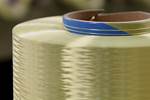F1 team debuts bio-based carbon fiber on W16 rear wheel shields
The technically performant components outfitting the Mercedes-AMG Petronas F1 Team’s race car were developed using Syensqo resin with 30% bio-based materials.
Source (All Images) | Mercedes-AMG Petronas
In March 2025, the was taking its first steps to qualify and apply sustainable carbon fiber composites into its W16 race car. At the end of September 2025, the Azerbaijan Grand Prix saw the debut of this bio-based carbon fiber composite material — rear brake duct wheel shields which were developed using a novel resin that includes 30% bio-based materials.
This marked the the first time the team used this kind of material on a technically performant component in race conditions. Applying these materials to the rear brake duct wheel shields — with their intricate aerodynamic surfaces — demonstrates the technology can withstand the extreme conditions of Formula One racing, and supports its potential for widespread adoption across the sport.
“This project with Syensqo [Brussels, Belgium and Alpharetta, Ga., U.S.] highlights our commitment to reduce our environmental impact while maintaining the highest standards of performance,” says Alice Ashpitel, head of sustainability. “The fact that these materials have been derived from byproducts associated with the creation of bio-diesel is an added benefit and indicates the power of advanced sustainable fuels.”
Syensqo’s bio-based resin technology supported the W16 race car project. “By replacing traditional petroleum-based components with those derived from renewable sources, we are not only introducing circularity in our product design but also paving the way for future innovations,” notes Rodrigo Elizondo, president of Syensqo Composite Materials.
Related Content
-
Carbon fiber, bionic design achieve peak performance in race-ready production vehicle
Porsche worked with Action Composites to design and manufacture an innovative carbon fiber safety cage option to lightweight one of its series race vehicles, built in a one-shot compression molding process.
-
Sulapac introduces Sulapac Flow 1.7 to replace PLA, ABS and PP in FDM, FGF
Available as filament and granules for extrusion, new wood composite matches properties yet is compostable, eliminates microplastics and reduces carbon footprint.
-
Development of a composite liquid hydrogen tank for commercial aircraft
Netherlands consortium advances cryogenic composites testing, tank designs and manufacturing including AFP, hybrid winding, welding of tank components and integrated SHM and H2 sensors for demonstrators in 2025.



